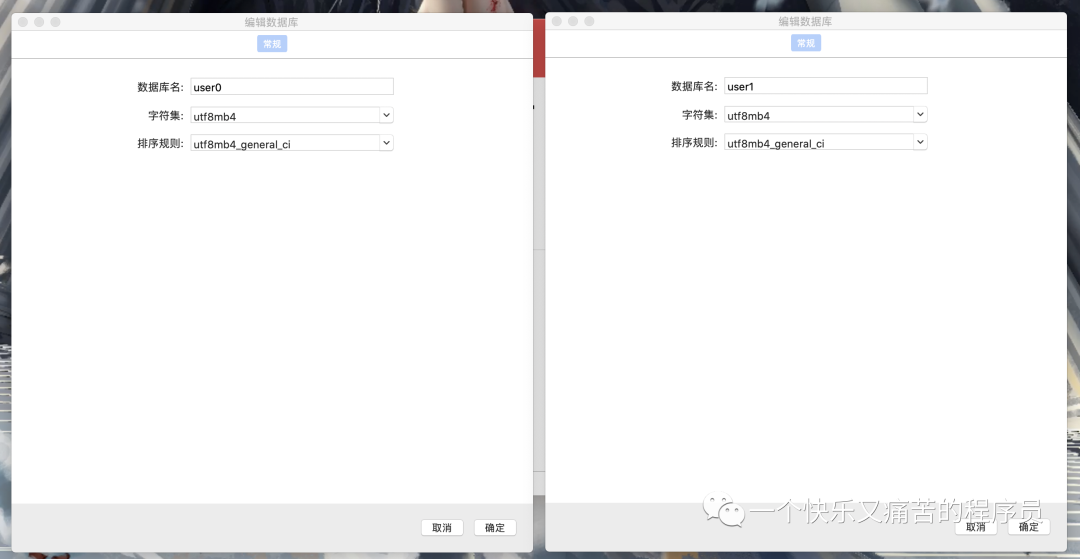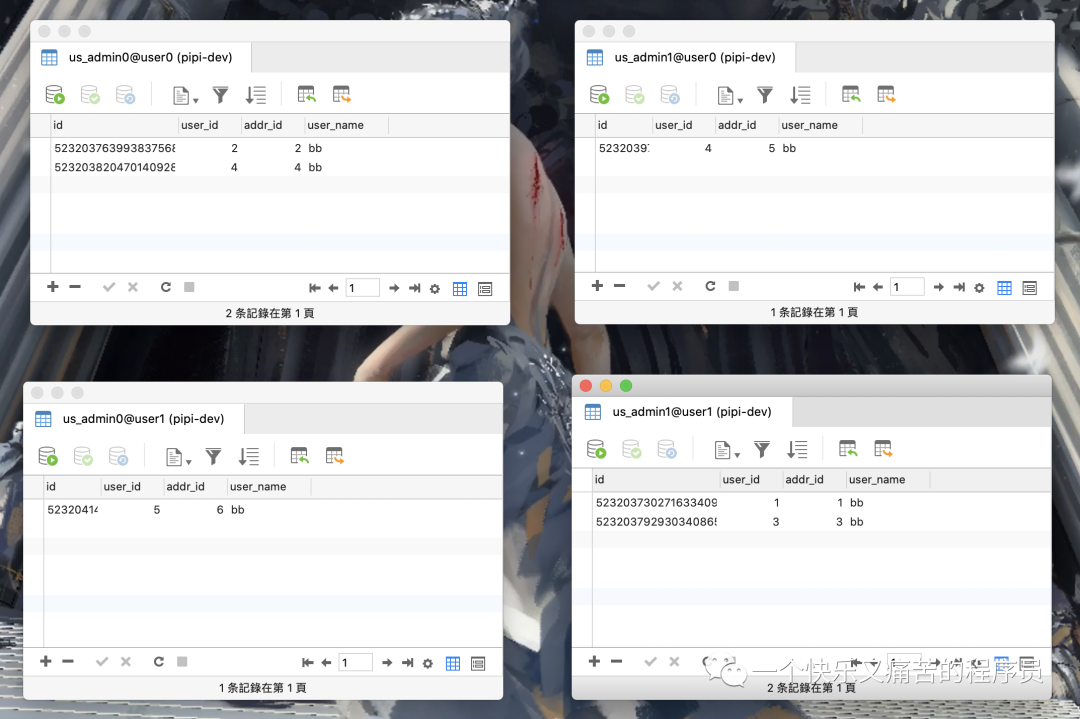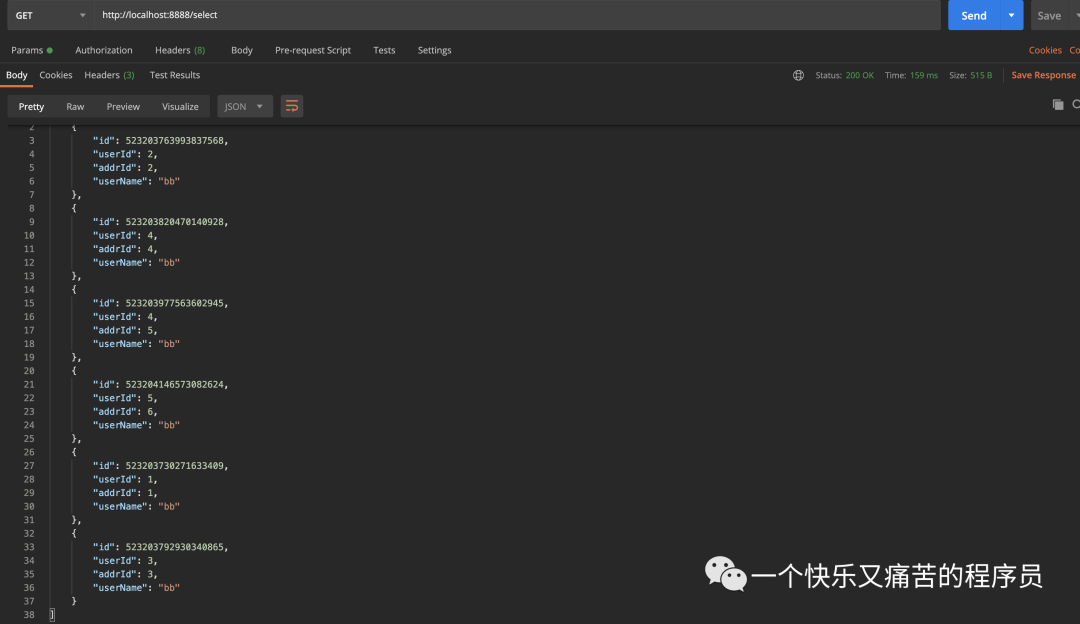当公司业务量上去之后,单表支撑不了的时候,分库分表就是一个绕不开的话题,小弟最近新入职一家公司,发现这边公司在用ShardingSphere来进行分库分表,之前没接触过这方面,所以就写了个demo学习一下,下面文章就记录一下如何用ShardingSphere来进行分库分表!(能力有限,本章不会讲原理奥,只是记录如何分库分表,原理方面后面我学习了再写,现在先会用先0.0,)
1、官网文档地址
这是ShardingSphere官网文档的地址,有需要的可以点进去看一下。
2、技术及环境
| 数据库 | 项目用到的技术 |
|---|---|
| mysql5.6 | springboot、mybatis、shardingsphere |
3、建库建表
1、新建两个数据库:一个user0,一个user1。
2、在user0数据库新建两个表:一个us_admin0,一个us_admin1,新建语句如下:
CREATE TABLE `us_admin0` (
`id` bigint(20) NOT NULL AUTO_INCREMENT COMMENT '主键ID',
`user_id` int(11) NOT NULL COMMENT '用户id',
`addr_id` int(11) NOT NULL COMMENT '地址id',
`user_name` varchar(64) NOT NULL COMMENT '用户编号',
PRIMARY KEY (`id`)
) ENGINE=InnoDB DEFAULT CHARSET=utf8mb4 COMMENT='后台用户表';
CREATE TABLE `us_admin1` (
`id` bigint(20) NOT NULL AUTO_INCREMENT COMMENT '主键ID',
`user_id` int(11) NOT NULL COMMENT '用户id',
`addr_id` int(11) NOT NULL COMMENT '地址id',
`user_name` varchar(64) NOT NULL COMMENT '用户编号',
PRIMARY KEY (`id`)
) ENGINE=InnoDB DEFAULT CHARSET=utf8mb4 COMMENT='后台用户表';
3、在user1数据库新建两个表:一个us_admin0,一个us_admin1,新建语句如下:
CREATE TABLE `us_admin0` (
`id` bigint(20) NOT NULL AUTO_INCREMENT COMMENT '主键ID',
`user_id` int(11) NOT NULL COMMENT '用户id',
`addr_id` int(11) NOT NULL COMMENT '地址id',
`user_name` varchar(64) NOT NULL COMMENT '用户编号',
PRIMARY KEY (`id`)
) ENGINE=InnoDB DEFAULT CHARSET=utf8mb4 COMMENT='后台用户表';
CREATE TABLE `us_admin1` (
`id` bigint(20) NOT NULL AUTO_INCREMENT COMMENT '主键ID',
`user_id` int(11) NOT NULL COMMENT '用户id',
`addr_id` int(11) NOT NULL COMMENT '地址id',
`user_name` varchar(64) NOT NULL COMMENT '用户编号',
PRIMARY KEY (`id`)
) ENGINE=InnoDB DEFAULT CHARSET=utf8mb4 COMMENT='后台用户表';
4、搭建springboot项目
这部分就idea自己创建一下就好了,pom文件及配置文件内容如下:
pom文件:
<?xml version="1.0" encoding="UTF-8"?>
"http://maven.apache.org/POM/4.0.0" xmlns:xsi="http://www.w3.org/2001/XMLSchema-instance"
xsi:schemaLocation="http://maven.apache.org/POM/4.0.0 https://maven.apache.org/xsd/maven-4.0.0.xsd">4.0.0org.springframework.bootspring-boot-starter-parent2.0.7.RELEASE com.shardingsphere1.0.0-SNAPSHOTsphereDemo project for Spring Boot1.8Hoxton.SR33.8.28.0.12junitjunit4.12testorg.springframework.bootspring-boot-starter-web-servicesorg.springframework.bootspring-boot-starter-testtestorg.junit.vintagejunit-vintage-engineorg.apache.shardingspheresharding-jdbc-spring-boot-starter4.0.0-RC1com.alibabadruid-spring-boot-starter1.1.14mysqlmysql-connector-javaorg.springframework.bootspring-boot-starter-actuatororg.mybatis.spring.bootmybatis-spring-boot-starter2.1.2org.springframework.bootspring-boot-maven-plugin
application.yml配置:
# 服务端口
server:
port: 8888
# 服务名
spring:
application:
name: test-user
# 配置sharding jdbc分片规则
shardingsphere:
datasource:
# 连接名称(下面要用这个名称来区分库)
names: ds0,ds1
ds0:
type: com.alibaba.druid.pool.DruidDataSource
driver-class-name: com.mysql.jdbc.Driver
url: jdbc:mysql://192.168.1.19:3306/user0?useUnicode=true&characterEncoding=utf8&allowMultiQueries=true&zeroDateTimeBehavior=convertToNull&useSSL=true&serverTimezone=GMT%2B8
username: root
password: 123
initialSize: 5 #初始化大小
maxActive: 200 #最大值
maxWait: 2000 #最大等待时间,配置获取连接等待超时,时间单位都是毫秒ms
timeBetweenEvictionRunsMillis: 60000 #配置间隔多久才进行一次检测,检测需要关闭的空闲连接
ds1:
type: com.alibaba.druid.pool.DruidDataSource
driver-class-name: com.mysql.jdbc.Driver
url: jdbc:mysql://192.168.1.19:3306/user1?useUnicode=true&characterEncoding=utf8&allowMultiQueries=true&zeroDateTimeBehavior=convertToNull&useSSL=true&serverTimezone=GMT%2B8
username: root
password: 123
initialSize: 5 #初始化大小
maxActive: 200 #最大值
maxWait: 2000 #最大等待时间,配置获取连接等待超时,时间单位都是毫秒ms
timeBetweenEvictionRunsMillis: 60000 #配置间隔多久才进行一次检测,检测需要关闭的空闲连接
# 配置分片规则
sharding:
# 按表来区分
tables:
us_admin:
# 配置数据节点
actualDataNodes: ds${0..1}.us_admin${0..1}
# 分库策略
databaseStrategy:
inline:
# 分库的规则 用user_id这个字段来分库 总共有两个库 及ds0(user0)与ds1(user1)
shardingColumn: user_id
algorithmExpression: ds${user_id % 2}
# 分表策略
tableStrategy:
inline:
shardingColumn: addr_id
algorithmExpression: us_admin${addr_id % 2}
keyGenerator:
column: id
type: SNOWFLAKE
bindingTables:
us_admin
broadcastTables:
t_config
defaultDataSourceName: ds0
props:
sql.show: true
# 配置xml 的扫描路径
mybatis:
mapper-locations: classpath:mapper/*.xml
check-config-location: true
type-aliases-package: com.sharding.sphere.model
configuration:
cacheEnabled: true
mapUnderscoreToCamelCase: true
5、接口测试
编写增删改接口进行测试,分库根据user_id来切片,分表根据addr_id来切片,分别插入一些数据,结果如下:
@RestController
public class UserController {
@Resource
UserService userService;
@RequestMapping("add")
public Integer add(@RequestBody UsAdmin usAdmin){
Integer add = userService.add(usAdmin);
return add;
}
@RequestMapping("select")
public List select(){
List select = userService.select();return select;
}@RequestMapping("delect")public Integer delect(Long id){
Integer delect = userService.delect(id);return delect;
}
}查询sql语句:
<select id="selectAll" resultMap="BaseResultMap">
select
id, addr_id, user_id, user_name
from us_admin
select>
新增sql语句:
<insert id="insertSelective" parameterType="com.sharding.sphere.model.UsAdmin">
insert into us_admin
<trim prefix="(" suffix=")" suffixOverrides=",">
<if test="id != null">
id,
if>
<if test="userId != null">
user_id,
if>
<if test="addrId != null">
addr_id,
if>
<if test="userName != null">
user_name,
if>
trim>
<trim prefix="values (" suffix=")" suffixOverrides=",">
<if test="id != null">
#{id,jdbcType=BIGINT},
if>
<if test="userId != null">
#{userId,jdbcType=INTEGER},
if>
<if test="addrId != null">
#{addrId,jdbcType=INTEGER},
if>
<if test="userName != null">
#{userName,jdbcType=VARCHAR},
if>
trim>
insert>
删除sql语句:
delete from us_admin
where id = #{id,jdbcType=BIGINT}
数据新增分表分库结果:

查询结果:

可以看到,新增数据的时候以user_id%2来计算分库,双数在user0库,单数在user1库,addr_id作为分表id,双数在us_admin0表,单数在us_admin1表,先确定库然后确定表,而查询一条语句可以查询到所有,不过ShardingSphere好像有些sql语句是不支持的,比如关联自己这种操作(us_admin left join us_admin这种),还有一些不支持的sql,具体的可以百度看看。
讲道理来看,ShardingSphere其实对代码的侵入量并不算多,只是有一些配置,配置好之后该写的sql跟原来一样的,可能是还没有踩到该踩的坑吧,等周末研究一下原理之后再写一篇文章分析分析。
6、公众号
如果你觉得我的文章对你有帮助话,欢迎关注我的微信公众号:"一个快乐又痛苦的程序员"(无广告,单纯分享原创文章、已pj的实用工具、各种Java学习资源,期待与你共同进步)
_Web题目 AreUserialz Writeup)
)














和打包命令)
...)

